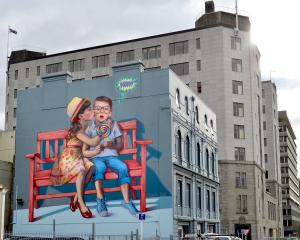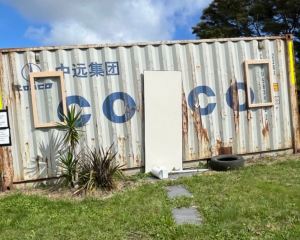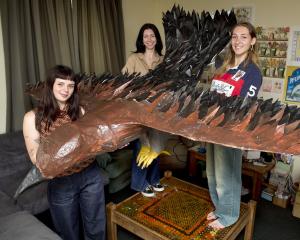
Megan Brady
(Favour)
MEGAN Brady’s interest in relationality, or the relationship between different entities, is evident even in the intentionally slippery language of the exhibition title: "The florist sent the flowers was pleased". Its slight grammatical imprecision invites reimagining or reworking, though not necessarily with the aim to "correct". While this may be my interpretation, the desire to resist fixed meaning or singular definition allows for a certain fluidity of relations and relationships that is more characteristic of encounters and negotiations with people, spaces or places and other sentient beings.
Brady’s relational installation works embody familial, friendship, and spatial connections and considerations. Each of the five wall-based assemblages comprise an Oregon tongue and groove shelf that, despite its apparent solidity, is designed to support the lightest of objects, including postcards (from photographs taken by Brady), slender plant leaves, seed pods, single stem flowers and handmade friendship bracelets. The latter are variously placed on the shelf, pressed into the groove of the shelf, or hang from the vertical support. It is difficult not to approach or describe these works (titled Buddy arrangements, 2020) as shrines — to histories, people, plant life — however overused the term may be. They are relational complements rather than interventions that coexist with plants and flowers in a space that is both a gallery (Favour) and a florist (Miss Reid). The friendship bracelets acknowledge friend and owner Jacqui Margetts and plants.

"Spring" Group exhibition
Milford Galleries
IN the 10th and 11th months of the year in Dunedin, it is not too late to present a spring-themed group exhibition. Especially one that takes as its curatorial origin the often-unseen exchanges and interactions that unfold and take form beneath the soil or in symbiotic interactions between soil, plants, insects and atmosphere. This is the world of chemical reactions, molecules and microbes, the latter of which cannot but infer micro-organisms including viruses or the virological. These associations make valid connections between climate, ecological entwinements and the consequences of taking too much from the earth.
Works by two artists in particular engage these interrelations: Caroline Earley’s polymorphic ceramic sculptures of interlocking amoebic forms, and Peter Trevelyan’s skeletal polymer structures encased in bell jars. Where Earley brings a pop sensibility to her appropriately egregious, uncannily sensuous, rounded small sculptures, Trevelyan’s spare, spiky geometric shapes and unruly towers are stripped of flesh, and perhaps struggling for oxygen in the specimen jar. Despite their quite different physical and formal manifestations, both sculptural styles animate sensuous and non-sensuous experiences of living in the Anthropocene — the era of socio-ecological crisis and extinction.
If winter is a temporary death, and spring a return to life, then our current season is a bittersweet vantage from which to apprehend pandemics, fires, melting ice and loss, because it is life itself that is threatened by climate emergency, including the recurrence of recognisable seasons such as spring.

"Windows", Katrina Beekhuis
(Blue Oyster)
IF I see a window or a window shape in the rectangular form of Drying rack assemblage, in the shape and space of Wire drawing (wall vent), or in the negative space of Sand chair (all works 2020), I run the risk of codifying my viewing experience of these works. In the short text by artist Katrina Beekhuis included in the publication accompanying her exhibition, Beekhuis questions this reflexive act of making sense of the world through association: this looks like that. Or more precisely, the speed of codification. Yet through the exhibition and work titles, and the works themselves, Beekhuis registers the perceptive impulse of the mind to connect like with like, to link experiences, to orient ourselves among the objects in our environments.
The exhibition title, "Window", for example, functions as a synonym of sorts for perception: the phenomenon and process that undergirds and orients Beekhuis’ practice. In the context of visual art practice, the figure and function of a window fittingly privileges visual perception. So in many ways (literally, conceptually, formally), Beekhuis has provided the visitor with a perceptual apparatus to apprehend the works, though it does not overdetermine the experience. To take one example, objects that appear to be found or repurposed objects (the drying rack) turn out to be carefully, even fastidiously handmade. Yet this attention is less in service of simulacrum, but directed towards the object itself: a care-driven fetishisation.
Robyn Maree Pickens












